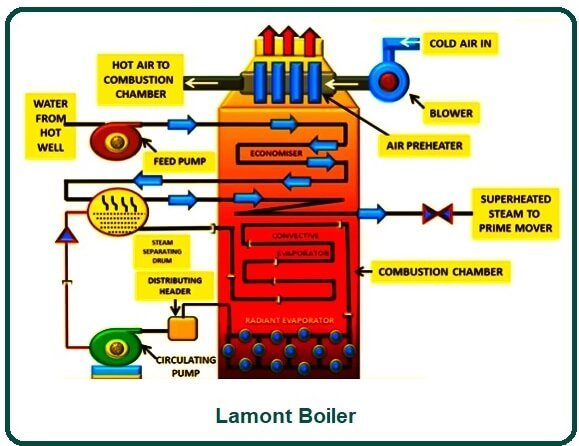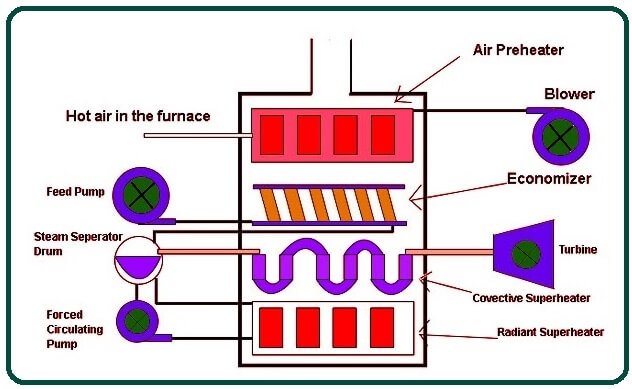
What Is Lamont Boiler?

The Lamont boiler is a high-pressure, forced circulation, internally fired furnace with a water tube boiler. An external pump is used to circulate water within the small diameter water tubes of the boiler.
This boiler was invented by Walter Douglas La-Mont in the year 1925. At that time, this boiler was invented. The Lamont boiler is the first forced convection boiler. It is a high-pressure water hose, which is forcibly removed. Boiler.
In Lamont boilers, external water tube pumps are used to circulate water within the boilers’ water tubes. Therefore, the water pressure in the tubes is higher than the water pressure in the natural circulation boiler. Lamont boilers are mainly used in power plant industries to generate electricity.
Parts of Lamont Boiler:

These are the main parts of the Lamont boiler:
#1. Feed Pump
The feed pump supplies water from the hot well to the boiler.
#2. Economizer
The economizer is used to raise the temperature of feed water to some extent.
#3. Centrifugal Pump
The centrifugal pump is used to circulate water inside the Lamont boiler as it is a forced circulation boiler. The pump is powered by a steam turbine, and the steam for this turbine is taken by the boiler. This boiler uses its own steam to drive its pump, which circulates water in it.
#4. Steam Separating Drum
The role of this part of the Lamont boiler is indicated by its name. It separates the steam from water.
#5. Super Heater
The steam produced by evaporation is saturated steam, and if the steam is used in a turbine, the turbine can cause corrosion. So the saturated steam is sent to the superheater, where it converts to superheated steam, and this superhit steam is sent to the turbine.
#6. Radiant Evaporator
A radiant evaporator heats water with the help of radiation. It is located near Bhatti.
#7. Convection Evaporator
The Convective Evaporator is located above the Radiant Evaporator. It heats water by convection process.
#8. Air Preheater
The air preheater is located near the top of the Lamont boiler. Its main function is to improve the thermal efficiency of the boiler before the air comes from the blower, and this preheated air is sent to the furnace.
#9. Blower
This blows air into the air preheater, which is further sent to the furnace to increase the effectiveness of the boiler.
Working of Lamont Boiler:
First, the air blower will blow air into the air preheater, where the air is preheated & sent to the furnace to increase the thermals efficiency of the boilers.
On the other hand, the water feed pump transmits water to the boiler’s economizer. The economist heats the water to some extent, and this water is sent to the steam separator drum.
After the steam separator drum, this water is circulated by an external centrifugal pump via a radiant evaporator which is driven by a steam turbine. A radiant evaporator heats water and converts some of the water into steam.
The water and steam mixture from the radiant evaporator is sent to the convection evaporator. In convection evaporation, the water is further heated, and most of the water is converted into saturated steam.
Water passes through both of these evaporators 10 – 15 times until almost all the water is converted into saturated steams.
The mixture of saturated steam & water is sent to a steam separator drum to separate the steam from the water. In the steam separator drum, steam is collected at the top of the drum, and the remaining water settles down.
This saturated steam present in the steam separator drum cannot be sent directly to the turbine as it will cause corrosion in the turbines.
So, the saturated steams are passed through the superheater, where the steam temperature rises to the desired level, and the saturated steam is converted into superheated steam.
The superhit steam is then sent either to the steam collecting drum or to the turbine to produce electricity. In addition, air from the air preheater reaches the furnace where the fuel burns. The flue gases from the furnaces first heat evaporator & then pass through the superheater.
This gas reaches the air preheater after passing through the superheater and is used to preheat the air before reaching France.
Construction of Lamont Boiler:
In a Lamont boiler, the air blower is connected to the air preheater and supplies air to it. It is connected to the air preheater furnace. The water feed pump is connected to the economizer, which preheats the water, and it is connected to the economizer steam separator drum.
The steam separator drum is connected to the radiant evaporator, which is located near the combustion chamber, and this radiant evaporator is connected to the convection evaporator, which is present above it.
The steam separator drum is also connected to the superheater, which heats the air to the desired level and then transfers the steam to the turbine to generate electricity.
Applications of Lamont Boiler:
The boiler is mostly used in power plants where steam turbines are used to produce electricity.
Advantages of Lamont Boiler:
These are some of the benefits of Lamont boilers:
- The Lamont boiler can generate a high amount of steam.
- It is easy to start operating.
- The construction design of the Lamont boilers is very simple and easy to understand.
- This boiler can reassemble with the natural circulation boiler, and It has a high heat transfer rate.
- It is flexible in design.
Faqs About Lamont Boilers
What Is a Lamont Boiler?
A Lamont boiler is a high-pressure, forced circulation water tube boiler used primarily in power plants to generate electricity. It was invented by Walter Douglas La-Mont in 1925.
How Does a Lamont Boiler Work?
The boiler uses an external pump to circulate water through its small-diameter water tubes. Water is heated through radiant and convective evaporators, separated from steam in a steam separator drum, and then superheated before being used in turbines.
What Are the Main Parts of a Lamont Boiler?
Key components include the feed pump, economizer, centrifugal pump, steam separating drum, superheater, radiant and convection evaporators, air preheater, and blower.
Where Are Lamont Boilers Primarily Used?
Lamont boilers are predominantly used in power plants where steam turbines are employed for electricity generation due to their high steam generation capacity and efficiency.
What Are the Advantages of Lamont Boilers?
Advantages include high steam generation capability, ease of operation startup, simple construction design, high heat transfer rate, and flexibility in design configurations.
Why Is Superheating Necessary in Lamont Boilers?
Superheating steam ensures it reaches a higher temperature, reducing the risk of turbine corrosion and increasing efficiency in electricity generation.
How Does a Lamont Boiler Compare to Natural Circulation Boilers?
Unlike natural circulation boilers, Lamont boilers use forced circulation with an external pump, enabling higher water pressure within the tubes for more efficient heat transfer and steam production.

